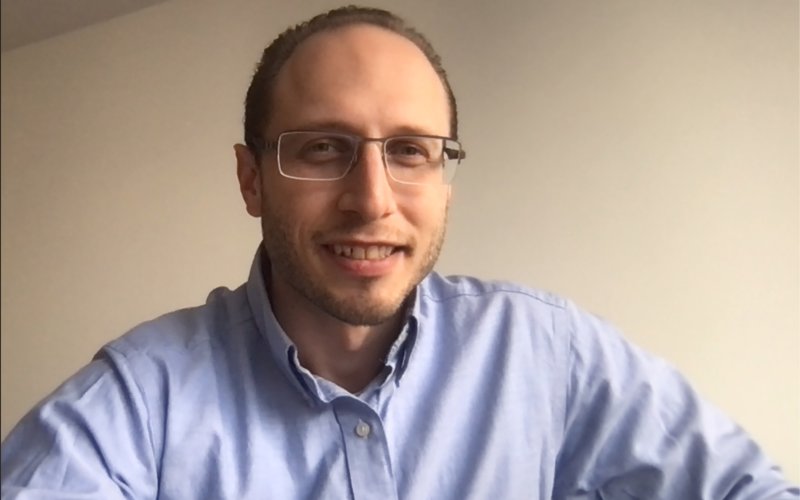Student Spotlight: Isaac Michaels on the ongoing challenges of the COVID-19 pandemic

April 24, 2023
DrPH student Isaac Michaels feels strongly about using his knowledge of public health and data analysis to serve his community. He recently published an op-ed in the Bronx Times advocating for an air quality census in New York schools with the ultimate goal of reducing SARS-CoV-2 transmission and improving overall health. We sat down for a conversation with Michaels on his past and current work, his commitment to data transparency, and the impact of the COVID-19 pandemic on his professional goals.
Where is 'home' for you?
I am proud to call New York state my home. My great grandparents immigrated to New York through Ellis Island, and today I'm the 3rd generation in my family to be born in New York City. I grew up in the Capital Region, graduated from SUNY schools (Binghamton University and the University at Albany), worked in Albany, moved to Manhattan, and now live in the Bronx. Protecting and promoting the health of New York is my passion.
What areas of public health interest you the most?
I’m interested in many aspects of public health, including public health practice, health equity, public health systems and infrastructure, and translating research into practice. These areas are important to me because they are foundational and essential for achieving public health goals.
Where do you currently work?
I am currently employed at NewYork-Presbyterian as a program director for research science. In this role, I apply analytics and research methods to support projects and initiatives spanning community health, health equity, quality and patient safety, and operations.
I also worked at the New York State Department of Health Office of Public Health Practice from 2015 through 2021 on a wide variety of projects, including the NYS Prevention Agenda, performance management and quality improvement infrastructure, health department reaccreditation, public health reviews of hospital Certificate of Need applications, public health funding and spending analysis, as well as opioid overdose data surveillance. Most of my work during 2020 and 2021 was in areas related to New York State’s COVID-19 response.
What public health challenges related to the pandemic are we still facing?
Despite certain improvements in the course of the COVID-19 pandemic, New York still faces a range of public health challenges. A very low percentage of New Yorkers are up to date on their COVID-19 vaccinations, and we have ongoing transmission coupled with declining surveillance. In the longer term, we still don’t know the full picture, but emerging evidence suggests that SARS-CoV-2 can have lasting negative effects on nearly every organ and organ system of the body, potentially years after infection. These include serious life-threatening conditions than can result in disability and death. Furthermore, we still see high mortality associated with COVID-19, which was the third leading underlying cause of death in New York State during 2022. The CDC estimates that there were over 16,000 excess deaths in New York State during 2022, beyond what would be expected during a normal pre-pandemic year.
The COVID-19 pandemic has exposed flaws in our public health system and caused a decline in overall health. America's Health Rankings dropped New York’s overall health rank from 11th in 2019 to 23rd in 2022; meanwhile, 3 of the 5 highest-ranked states are New York's bordering neighbors (Massachusetts, Vermont, Connecticut). Among all U.S. states and the District of Columbia, New York State experienced the largest decline in life expectancy at birth, dropping three percent, from 80.7 years in 2019 to 77.7 years in 2020, according to an August 2022 report by the National Vital Statistics System. The main contributor to this decline in health was the ongoing COVID-19 pandemic.
These high rates of morbidity and mortality coincide with growing public resistance to mitigation measures of any kind. We have seen rampant demonization of science and scientists, an unprecedented level of misinformation and disinformation, and the politicization of public health institutions. All of these factors inhibit our ability to respond effectively to future disease outbreaks.
How has the pandemic influenced your professional goals?
Two of my long-term goals are to create and strengthen collaborations between public health and clinical medicine, and to improve the use of data in health care and public health practice by deriving as much insight as possible from data already collected.
One thing that I began working on during the pandemic is my personal website. I created the site in March of 2020, both to be a central repository for projects I’d worked on previously, and to share analyses and visualizations I was developing and tracking using the few COVID-19 data sources that were publicly available at the time. Over time, I’ve expanded the site substantially. All of the analyses on the site are conducted using publicly available data and open-source software. I believe in the power of open data and open-source software to drive positive change and promote transparency, and I am committed to using these tools to create meaningful and impactful content for the site. I update the site on a daily basis.
Any last thoughts you’d like to share?
The rapid development of safe and effective COVID-19 vaccines was a landmark achievement for public health and medicine, and I’m excited about the potential for mRNA platforms to give us vaccine and therapeutic breakthroughs against other pathogens beyond SARS-CoV-2. However, I have also been frustrated to see the premature dismantling of basic infection-control precautions in New York state and other places – without transparent data-informed milestones first being reached. The early days of the pandemic showed us how important timely, accurate data are, and we are losing sight of the lessons we learned.


